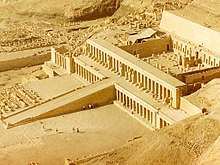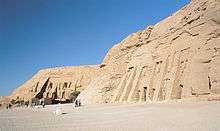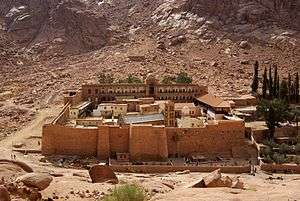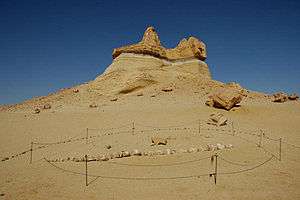List of World Heritage sites in Egypt
Location of World Heritage sites in Egypt
This is a list of World Heritage sites in Egypt with properties of cultural and natural heritage in Egypt as inscribed in UNESCO's World Heritage list or as on the country's tentative list. As of 2016, eight sites in Egypt are included.[1] In addition to its inscribed sites, Egypt also lists thirty-three properties on its tentative list.[1]
World Heritage sites
| Site | Image | Location | Criteria | Area ha (acre) |
Year | Description |
|---|---|---|---|---|---|---|
| Abu Mena | Alexandria Governorate, 30°51′00″N 29°40′00″E / 30.85000°N 29.66667°E |
Cultural: (iv) |
183 (450) | 1979 | The ruins of the former Christian holy city contain a church, a baptistery, basilicas, public buildings, streets, monasteries, houses, and workshops, and were built over the tomb of Menas of Alexandria.[2] | |
| Ancient Thebes with its Necropolis |  |
Luxor Governorate, 25°44′00″N 32°36′00″E / 25.73333°N 32.60000°E |
Cultural: (i)(iii)(vi) |
7,390 (18,300) | 1979 | The former capital of Egypt and the city of Amun, Thebes contains temples and palaces at Karnak and Luxor, as well as the necropolises at the Valley of the Kings and the Valley of the Queens, bearing witness to the height of the Egyptian civilization.[3] |
| Historic Cairo | .jpg) |
Cairo Governorate, 30°03′00″N 31°15′40″E / 30.05000°N 31.26111°E |
Cultural: (i)(v)(vi) |
524 (1,290) | 1979 | One of the world's oldest Islamic cities and in the middle of urban Cairo, the site dates from the 10th century and reached its golden age in the 14th century. It contains mosques, madrasah, hammams and fountains.[4] |
| Memphis and its Necropolis – the Pyramid Fields from Giza to Dahshur |  |
Cairo Governorate, 30°03′00″N 31°15′40″E / 30.05000°N 31.26111°E |
Cultural: (i)(v)(vi) |
16,358.52 (40,422.8) | 1979 | The capital of the Old Kingdom of Egypt has some extraordinary funerary monuments, including rock tombs, ornate mastabas, temples and pyramids. In ancient times, the site was considered one of the Seven Wonders of the World.[5] |
| Nubian Monuments from Abu Simbel to Philae |  |
Aswan Governorate, 22°20′11″N 31°37′34″E / 22.33639°N 31.62611°E |
Cultural: (i)(iii)(vi) |
374 (920) | 1979 | Located along the Nile, the site contains monuments such as the Temple of Ramesses II at Abu Simbel and the Sanctuary of Isis at Philae, saved from being submerged by Lake Nasser as a result of the construction of the Aswan Dam.[6] |
| Saint Catherine Area |  |
South Sinai Governorate, 28°33′22″N 33°58′32″E / 28.55611°N 33.97556°E |
Cultural: (i)(iii)(iv)(vi) |
60,100 (149,000) | 2002 | The orthodox monastery of Saint Catherine is among the oldest Christian monasteries still in function. Dating from the 6th century, it is positioned near Mount Horeb where, according to the Old Testament, Moses received the Tablets of the Law. The region is sacred for Christians, Muslims and Jews.[7] |
| Wadi Al-Hitan (Whale Valley) |  |
Faiyum Governorate, 29°20′00″N 30°11′00″E / 29.33333°N 30.18333°E |
Natural: (viii) |
20,015 (49,460) | 2005 | Located in western Egypt, Wadi Al-Hitan contains fossil remains of the now extinct Archaeoceti, mapping the evolution of the whales from a land-based to an aquatic mammal.[8] |
Tentative list
In addition to sites inscribed on the World Heritage list, member states can maintain a list of tentative sites that they may consider for nomination. Nominations for the World Heritage list are only accepted if the site was previously listed on the tentative list.[9] As of 2016, Egypt lists thirty-three properties on its tentative list:[1]
See also
References
- 1 2 3 "Egypt". UNESCO. Retrieved 20 July 2017.
- ↑ "Abu Mena". UNESCO. Retrieved 17 August 2011.
- ↑ "Ancient Thebes with its Necropolis". UNESCO. Retrieved 17 August 2011.
- ↑ "Historic Cairo". UNESCO. Retrieved 17 August 2011.
- ↑ "Memphis and its Necropolis – the Pyramid Fields from Giza to Dahshur". UNESCO. Retrieved 24 December 2016.
- ↑ "Nubian Monuments from Abu Simbel to Philae". UNESCO. Retrieved 17 August 2011.
- ↑ "Saint Catherine Area". UNESCO. Retrieved 17 August 2011.
- ↑ "Wadi Al-Hitan (Whale Valley)". UNESCO. Retrieved 17 August 2011.
- ↑ "Tentative Lists". UNESCO. Retrieved 7 October 2010.
This article is issued from
Wikipedia.
The text is licensed under Creative Commons - Attribution - Sharealike.
Additional terms may apply for the media files.
